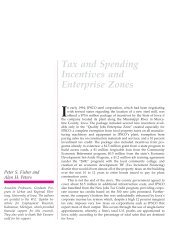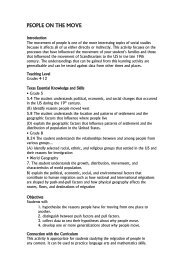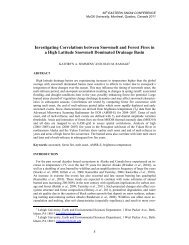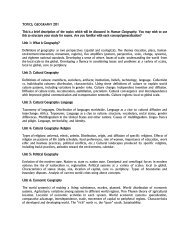Texas Social Studies Framework - Department of Geography ...
Texas Social Studies Framework - Department of Geography ...
Texas Social Studies Framework - Department of Geography ...
Create successful ePaper yourself
Turn your PDF publications into a flip-book with our unique Google optimized e-Paper software.
Chapter 7: Pr<strong>of</strong>essional Development in <strong>Social</strong> <strong>Studies</strong><br />
• Training: This model is the most common.<br />
Trainers determine objectives, design learning<br />
activities, and develop outcomes based on needs<br />
they identify. Attendees then participate in the<br />
training. The best training includes theory,<br />
practice, and implementation with feedback and<br />
coaching. Trainees benefit the most from training<br />
if they have time to devise ways to apply the<br />
information to their unique circumstances during<br />
the experience.<br />
Example: <strong>Social</strong> studies teachers and building<br />
staff may attend an institute to learn how to<br />
implement technology in the classroom. The<br />
most successful experience includes an overview<br />
<strong>of</strong> the ways technology can enhance<br />
instruction, practical suggestions about incorporating<br />
technology, and an opportunity to practice<br />
and gain feedback from the instructor during the<br />
training.<br />
Institutional support is critical to making<br />
training effective. Teachers may gain considerable<br />
information but not be able to put it to work<br />
if their school does not have the expertise or<br />
equipment to incorporate technology into<br />
instruction. Support should be assured before<br />
training to ensure that the experience is not<br />
wasted. Then staff can make necessary purchases,<br />
and teachers can return to their classroom<br />
and begin to guide students in learning to<br />
use technology.<br />
• Observation/Assessment: This model involves a<br />
peer review process, with someone observing a<br />
teacher while delivering instruction and then<br />
providing feedback and/or reflection soon<br />
afterward. It is most effective when set in a<br />
larger context <strong>of</strong> pr<strong>of</strong>essional growth activities.<br />
For instance, teachers who participate in an inservice<br />
day may follow-up the training session<br />
by asking a peer to observe a lesson that applies<br />
the suggestions gained from the in-service. Once<br />
the teacher receives feedback from the observer<br />
and makes necessary refinements and adjustments,<br />
the teacher fully implements the new<br />
practice and determines the level <strong>of</strong> impact on<br />
student performance.<br />
Example: Each Education Service Center (ESC)<br />
in <strong>Texas</strong> includes a team composed <strong>of</strong> teachers<br />
and education specialists who can provide<br />
TEKS-based, in-service experiences. The ESC<br />
73<br />
73<br />
team members receive training from SSCED<br />
and in turn share this with interested teachers,<br />
staff, and PTAs in their region. After teachers<br />
participate in these training sessions, they must<br />
then put the information to work, aligning their<br />
lessons with the expectations <strong>of</strong> their TEKSbased<br />
local curriculum. A peer can observe the<br />
refined instruction, assess the delivery, observe<br />
the assessment documents, assess their validity,<br />
and <strong>of</strong>fer comments that the teacher can<br />
incorporate.<br />
• Involvement in a Development/Improvement<br />
Process: In this model, teachers assess current<br />
practices, identify a problem, and pose a solution<br />
that will improve student performance. New<br />
knowledge and skills are acquired as solutions<br />
are worked through and problems are solved.<br />
Example: Serving on a curriculum writing task<br />
force requires that the teacher take a broad look<br />
at how students develop in learning social<br />
studies across the grades. Through this experience,<br />
teachers learn more about social studies<br />
content and skills. They also gain insight into<br />
how students learn. An added benefit is that<br />
teachers gain a perspective <strong>of</strong> how what they<br />
teach fits into the students’ total development.<br />
Teachers not involved in a curriculum writing<br />
project can still gain a greater awareness <strong>of</strong> the<br />
material students are exposed to across the<br />
grades by studying the TEKS for <strong>Social</strong> <strong>Studies</strong>.<br />
An abbreviated version created by SSCED<br />
features highlights from all strands <strong>of</strong> the TEKS<br />
for <strong>Social</strong> <strong>Studies</strong> for all grade levels and<br />
courses.<br />
• Inquiry: In this model, teachers formulate<br />
questions about their own practice and look for<br />
answers to these questions. The process includes<br />
identification <strong>of</strong> a problem, data collection, data<br />
analysis, and changes in practice.<br />
Example: A social studies teacher might want to<br />
know which reading strategies make a difference<br />
in the level <strong>of</strong> student understanding <strong>of</strong><br />
primary sources and documents related to the<br />
social studies. The teacher would research the<br />
question, learn techniques, use them in the<br />
classroom, and make adjustments until the<br />
question is resolved.
















